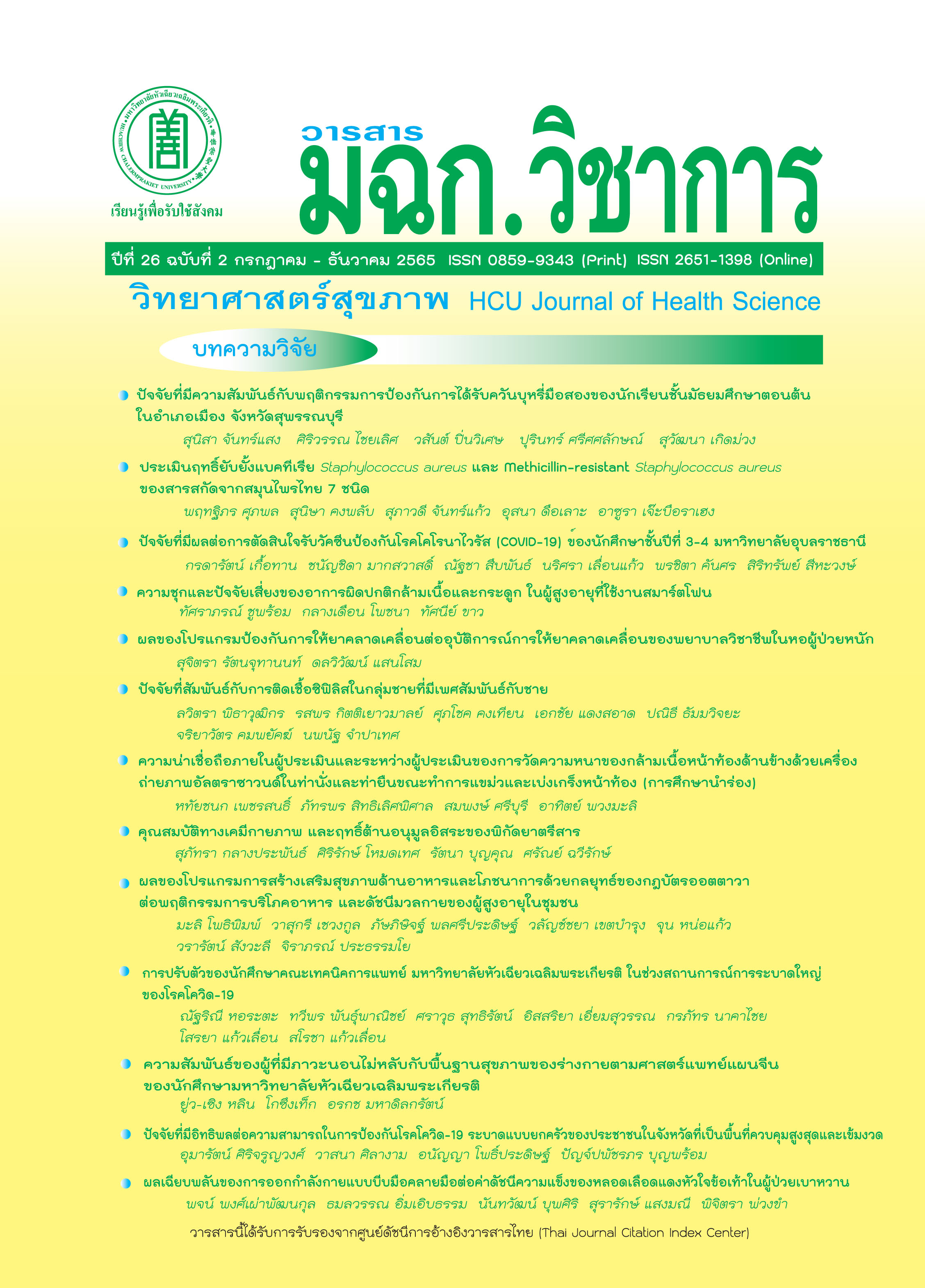ความชุกและปัจจัยเสี่ยงของอาการผิดปกติกล้ามเนื้อและกระดูก ในผู้สูงอายุที่ใช้งานสมาร์ตโฟน
คำสำคัญ:
ความชุก, อาการผิดปกติของกล้ามเนื้อและกระดูก, ผู้สูงอายุ, สมาร์ตโฟนบทคัดย่อ
ปัจจุบันผู้สูงอายุให้ความสนใจเทคโนโลยีมากขึ้น และใช้งาน “สมาร์ตโฟน” ในชีวิตประจำวัน ซึ่งการใช้สมาร์ตโฟนเป็นเวลานาน อาจนำไปสู่ความผิดปกติของกล้ามเนื้อและกระดูก วัตถุประสงค์ของงานวิจัยนี้ เพื่อศึกษาความชุกของอาการผิดปกติของกล้ามเนื้อและกระดูก และวิเคราะห์ปัจจัยที่มีผลกระทบต่ออาการผิดปกติของกล้ามเนื้อและกระดูกของผู้สูงอายุที่ใช้งานสมาร์ตโฟน เก็บข้อมูลด้วยแบบสัมภาษณ์เกี่ยวกับ ข้อมูลส่วนบุคคล ลักษณะการใช้งานสมาร์ตโฟน และความชุกของอาการผิดปกติของกล้ามเนื้อและกระดูก จากการใช้งานสมาร์ตโฟน ผลการศึกษาพบว่า ผู้สูงอายุร้อยละ 90.72 ใช้งานสมาร์ตโฟนในแต่ละวันมีความถี่มากกว่าหรือเท่ากับ 2 ชั่วโมงต่อวัน ซึ่งความชุกโดยรวมของอาการผิดปกติของกล้ามเนื้อและกระดูก พบว่ามีอาการปวดเมื่อยกล้ามเนื้ออย่างน้อยหนึ่งบริเวณ (100.00%) บริเวณที่พบบ่อยที่สุดคือ คอ ร้อยละ 62.89 หลังส่วนบน ร้อยละ 53.61 และหัวไหล่ ร้อยละ 45.36 ตามลำดับ จากการศึกษาปัจจัยเสี่ยง พบว่าระยะเวลาที่ใช้สมาร์ตโฟนมากกว่าหรือเท่ากับ 120 นาทีต่อวัน มีความสัมพันธ์กับอาการปวดบริเวณคอ (OR=5.90, 95%CI: 1.12-31.02) และหลังส่วนบน (OR=9.40, 95%CI: 1.11 79.61) เมื่อเทียบกับการใช้สมาร์ตโฟน น้อยกว่า 120 นาทีต่อวัน นอกจากนั้นยังพบว่า การใช้ขนาดหน้าจอสมาร์ตโฟนมากกว่า 6 นิ้ว มีความสัมพันธ์กับอาการปวดบริเวณกล้ามเนื้อแขน (OR=2.72, 95%CI: 1.14-6.47), ข้อมือ (OR=2.96, 95%CI : 1.16-7.52) เทียบกับหน้าจอสมาร์ตโฟนขนาดน้อยกว่า 6 นิ้ว ซึ่งอาการผิดปกติของกล้ามเนื้อและกระดูก ถือว่าเป็นปัญหาสุขภาพที่สามารถพบได้บ่อย ข้อมูลที่ได้สามารถนำไปเป็นแนวทางการลดระดับความเสี่ยงที่ส่งผลต่อการเกิดอาการผิดปกติของกล้ามเนื้อและกระดูก และแนวทางการป้องกันการเกิดอาการผิดปกติของกล้ามเนื้อและกระดูก เพื่อปกป้องกลุ่มเสี่ยงเหล่านั้น
Downloads
References
Kuljitjuerwong S. Social media trap the role of communicating technology in digital Era. CUTJ. 2013;19(2):268–79.
We Are Social. Digital 2022 Thailand (February 2022) [Internet]. UpToDate; 2022 cited 2022 Aug 23]. Available from: https://www.slideshare.net/DataReportal/digital-2022-thailand-february-2022-v01
Prasertsuk J. Digital literacy and the aging society [Internet]. Digital Economy Promotion Agency (Depa). [cited 2021 Nov 23]. Available from: https://www.depa.or.th/th/article-view/digital-literacy
European Commision. Undesa-United nations department of economic and social affairs [Internet]. Knowledge for policy-European Commission [Internet]. ค.ศ. [cited 2020 Jul 2]. Available from: https://ec.europa.eu/knowledge4policy/organisation/undesa-united-nations-department-economic-social-affairs_en.html
Department of Older Persons (DOP). The current aging society and economy in Thailand [Internet]. UpToDate 2022 [cited 2022 Aug 23]. Available from: https://www.dop.go.th/th/know/side/1/1/1159
The National Statistical Office. Statistical Office Revealing the results of a survey on the use of information and communication technology in the household [Internet]. ค.ศ. [cited 2020 Mar 18]. Available from: http://www.nso.go.th/sites/2014/Pages/News/2561/N26-10-61
Suwancharoen S, Thamma-in S, Kerdmuang S, Pinitchan O, Chumchai P. Behaviors and effects of smartphone usage among high school students, Nonthaburi province. NJPH 2019;29(3):107–17.
Rammayan T, Boonyarit P. Prevalence of musculoskeletal symptoms at upper body parts due to smartphone using among lower secondary school students. Srinagarind Med J 2016; 31(6):392–9.
Sungkhapong A, Pochana K. Skeleton system. Ergonomics risk assessment. 1st. Songkhla: Educational Technology Faculty of Engineering, Prince of Songkhla University; 2013. pp.19-67.
Tapanya W, Puntumetakul R. Prevalence and risk factors of musculoskeletal disorders in smartphone users. Thai J Phys Ther 2019;41(3):148–63.
Silanoi L. How to use the appropriate statistical formulas for determining the sample size for quantitative research designs in the humanities and social science study. RDIBRU 2017; 12(2):50–61.
Berolo S, Wells RP, Amick BC. Musculoskeletal symptoms among mobile hand-held device users and their relationship to device use: A preliminary study in a Canadian university population. Applied Ergonomics 2011;42(2):371–8.
Intolo P. Comparison of muscular pain during smartphone use among three age groups: elementary school student, high school student and office worker. JHSR 2018;12(2):328-41.
Khruakhorn S. Prevalence and associated risk factors of thumb pain from using smartphone in secondary school students at Klongluang, Pathumthani. TMJ 2017;17:18–26.
Gold JE, Driban JB, Thomas N, Chakravarty T, Channell V, Komaroff E. Postures, typing strategies, and gender differences in mobile device usage: An observational study. Applied Ergonomics 2012;43(2):408–12.
Kim H-J, Kim J-S. The relationship between smartphone use and subjective musculoskeletal symptoms and university students. J Phys Ther Sci 2015;27(3):575–9.
Stalin P, Abraham SB, Kanimozhy K, Prasad RV, Singh Z, Purty AJ. Mobile Phone Usage and its Health Effects Among Adults in a Semi-Urban Area of Southern India. J Clin Diagn Res 2016; 10(1):14–6.
Namwongsa S, Puntumetakul R, Neubert MS, Boucaut R. Factors associated with neck disorders among university student smartphone users. Work 2018;61(3):367–78.
Namwongsa S, Puntumetakul R, Neubert MS, Boucaut R. Effect of neck flexion angles on neck muscle activity among smartphone users with and without neck pain. Ergonomics 2019; 62(12):1524–33.
Zhi shan, Deng G, Li J, Li Y, Zhao Q, Zhang Y. Correlational analysis of neck/shoulder pain and low back pain with the use of digital products, physical activity and psychological status among adolescents in Shanghai. PLOS ONE 2013;8(10):1-9.
Sea-jern NN, Pochana K, Sungkhapong A. The prevalence and personal factors related to musculoskeletal disorders in occupational van drivers: a case study of public transport center in Hatyai, Songkhla. Asia Pac J Sci Technol 2014;19(1):107-18.
Downloads
เผยแพร่แล้ว
How to Cite
ฉบับ
บท
License
Copyright (c) 2022 วารสาร มฉก.วิชาการ

This work is licensed under a Creative Commons Attribution-NonCommercial-NoDerivatives 4.0 International License.
บทความที่ได้รับการตีพิมพ์เป็นลิขสิทธิ์ของวารสารวิทยาศาสตร์สุขภาพและสุขภาวะ
ข้อความที่ปรากฏในบทความแต่ละเรื่องในวารสารวิชาการเล่มนี้เป็นความคิดเห็นส่วนตัวของผู้เขียนแต่ละท่านไม่เกี่ยวข้องกับมหาวิทยาลัยหัวเฉียวเฉลิมพระเกียรติ และคณาจารย์ท่านอื่นๆในมหาวิทยาลัยฯ แต่อย่างใด ความรับผิดชอบองค์ประกอบทั้งหมดของบทความแต่ละเรื่องเป็นของผู้เขียนแต่ละท่าน หากมีความผิดพลาดใดๆ ผู้เขียนแต่ละท่านจะรับผิดชอบบทความของตนเองแต่ผู้เดียว



